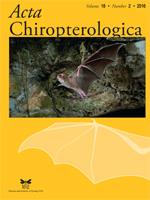More than half of the extant bat species rely on plants as roosts. Nevertheless, it is largely unknown how bats find these roosts and whether they use characteristic plant structures for their identification. The bat Kerivoula hardwickii regularly roosts in damaged pitchers of the carnivorous pitcher plant Nepenthes bicalcarata. These pitchers are characterized by two sharp, long thorns directly above the pitchers' opening. In two behavioural experiments we tested, if 1) the length of the thorns or 2) the distance between thorns and pitcher opening has an attractive or deterrent effect on K. hardwickii. The bats preferred pitchers with longer thorns while the distance between thorns and pitcher opening did not influence them. This shows that the bats are not deterred by the thorns. It also suggests that they do not exploit the pitchers' thorns as a protection against being preyed on while roosting. In this case the bats should have chosen pitchers with thorns close to the pitcher's opening that provide the most effective protection. Instead, K. hardwickii seem to use the thorns as identification cues to find suitable roost sites. Generally, our study suggests that bats even attend to plant structures that do not provide them with a direct benefit.
How to translate text using browser tools
1 December 2016
Bats Attend to Plant Structures to Identify Roosting Sites
Michael G. Schöner,
Caroline R. Schöner,
Gerald Kerth,
Liaw Lin Ji,
T. Ulmar Grafe
ACCESS THE FULL ARTICLE

Acta Chiropterologica
Vol. 18 • No. 2
December 2016
Vol. 18 • No. 2
December 2016
bat-plant interaction
Kerivoula
Nepenthes
pitcher plant
roost finding




